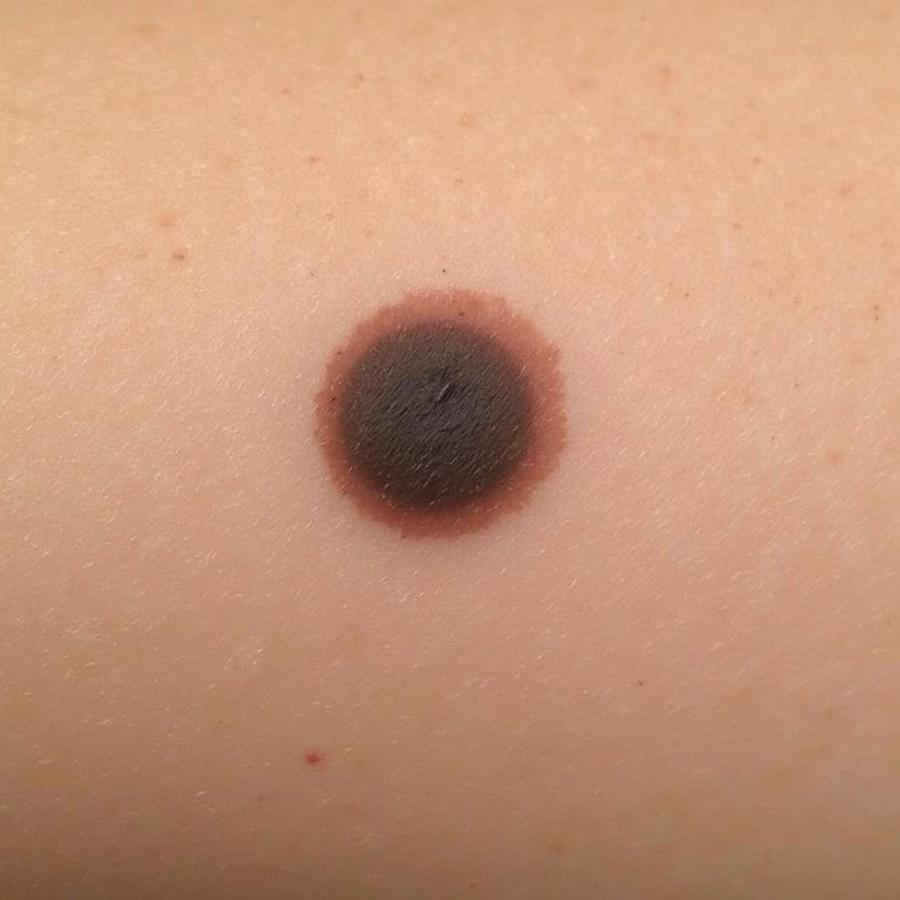Dog moles, also known as pigmented nevi, are common skin growths in dogs. Many dog owners search for “dog moles pictures” to compare their dog’s spots with images online. This article will help you understand what dog moles look like, the different types, and when you should seek veterinary attention.
Types of Dog Moles: Identifying What’s Normal
Just like in humans, dog moles can vary in size, shape, and color. They can be flat or raised, pigmented or flesh-colored. Most dog moles are benign and don’t pose a health risk. However, understanding the different types can help you monitor your dog’s skin health.
Benign Dog Moles: Nothing to Worry About
The most common type of dog mole is the melanocytic nevus, which arises from pigment-producing cells called melanocytes. These moles are typically small, dark, and well-defined.  Nốt ruồi sắc tố lành tính ở chó They can appear anywhere on the body and may be present from birth or develop later in life. Another benign type is the sebaceous adenoma, originating from oil glands in the skin. These are often raised, wart-like growths and can be flesh-colored or slightly pigmented.
Nốt ruồi sắc tố lành tính ở chó They can appear anywhere on the body and may be present from birth or develop later in life. Another benign type is the sebaceous adenoma, originating from oil glands in the skin. These are often raised, wart-like growths and can be flesh-colored or slightly pigmented.
Potentially Problematic Moles: Keeping a Watchful Eye
While most moles are harmless, some can develop into cancerous growths, particularly in older dogs. Melanomas, a type of skin cancer, can originate from existing moles or appear as new growths. pictures of moles on dogs can be helpful for comparison, but it’s essential to consult a veterinarian for an accurate diagnosis. Melanomas can appear as dark, irregularly shaped, rapidly growing masses. They can also bleed or ulcerate. Another concerning growth is the histiocytoma, which is common in young dogs. While generally benign and often regress spontaneously, some histiocytomas can be aggressive and require removal.
When Should You Worry About Your Dog’s Moles?
Regularly checking your dog’s skin for any changes is crucial. The ABCDE rule can help you assess potentially problematic moles:
- Asymmetry: Is the mole asymmetrical?
- Border: Are the borders irregular or jagged?
- Color: Has the color changed or become uneven?
- Diameter: Has the mole grown larger than a pencil eraser?
- Evolving: Has the mole changed in size, shape, color, or elevation?
If you notice any of these changes, pinscher dogs pictures won’t provide the answers you need. Consult your veterinarian immediately for a professional evaluation.
Dog Mole Removal: What to Expect
If your veterinarian suspects a cancerous growth, they may recommend a biopsy or surgical removal. The procedure is typically straightforward and involves removing the mole and a small margin of surrounding tissue. The removed tissue is then sent to a laboratory for analysis to confirm the diagnosis.
Conclusion: Monitoring Your Dog’s Skin Health is Key
While most dog moles are benign, regular monitoring and awareness of the ABCDE rule are vital for early detection of any potentially cancerous growths. Remember, the black dog locations won’t help you understand your dog’s moles. “Dog moles pictures” can be a starting point, but a veterinary diagnosis is essential for accurate assessment and appropriate treatment.
FAQ
- Q: Are all dog moles cancerous? A: No, the vast majority of dog moles are benign.
- Q: Can dog moles spread to humans? A: No, dog moles are species-specific and cannot be transmitted to humans.
- Q: How often should I check my dog’s skin for moles? A: Monthly skin checks are recommended.
- Q: Can sun exposure cause dog moles? A: While sun exposure can increase the risk of certain skin cancers in dogs, it is not directly linked to the development of common dog moles.
- Q: What is the difference between a mole and a skin tag? A: Moles are pigmented growths arising from melanocytes, while skin tags are flesh-colored, benign growths of skin.
- Q: Is it safe to remove a dog mole at home? A: No, never attempt to remove a dog mole at home. It’s essential to consult a veterinarian for proper diagnosis and treatment.
- Q: How much does it cost to remove a dog mole? A: The cost varies depending on the size and location of the mole, as well as your veterinarian’s fees.
Other questions you might be interested in: What are the signs of skin cancer in dogs? What are the different types of dog skin growths?
Related articles on Beaut Dogs: pictures of cutaneous hemangiosarcoma in dogs, dog eyelid skin tag
Beaut Dogs is your go-to resource for all things related to dog care, providing reliable and in-depth information on a variety of breeds, health concerns, and training tips. When you need assistance, please contact us via Email: [email protected] so that Beaut Dogs can give you detailed and accurate answers. Visit https://beautdogs.com today to explore the wonderful world of canine companionship!